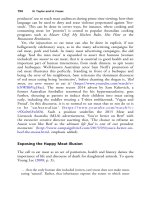The palgrave international handbook of a 473
Bạn đang xem bản rút gọn của tài liệu. Xem và tải ngay bản đầy đủ của tài liệu tại đây (36.43 KB, 1 trang )
Animals in War
Ryan Hediger
Introduction
Nonhuman animals (henceforth, ‘animals’) have been involved in human
wars as long as there have been wars. Indeed, given the exceedingly long
association between humans and dogs, it is likely that dogs performed
informal defensive roles for human encampments before war even existed.
Thus, human/animal partnerships likely predate war as such and are more
fundamental than the waging of war. This point is underscored by primatologist Frans De Waal, for instance, in his book The age of empathy. There, he
challenges what he calls the ‘false origin myth’ of human beings ‘that our
species has been waging war for as long as it has been around’ (2009, p. 22).
De Waal also asserts, ‘Although archeological signs of individual murder go
back hundreds of thousands of years, we lack similar evidence for warfare
(such as graveyards with weapons embedded in a large number of skeletons)
from before the agricultural revolution’ (pp. 22–23). Instead of making some
essentialist link between war and human nature, then, De Waal argues only
‘that our species has a potential for warfare’ and that ‘our ancestors probably
never waged war on a grand scale until they settled down and began to
accumulate wealth by means of agriculture. This made attacks on other groups
more profitable’ (24–25, De Waal’s emphasis). On this point, De Waal joins a
R. Hediger (*)
English Department, Kent State University, Kent, Ohio, USA
e-mail:
© The Author(s) 2017
J. Maher et al. (eds.), The Palgrave International Handbook of Animal
Abuse Studies, DOI 10.1057/978-1-137-43183-7_22
475









